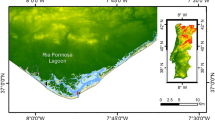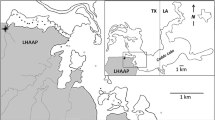Abstract
Both structural and functional relationships were investigated in experiments using S. capricornutum populations and an indigenous microbial community. Our aims were to diagnose cellular stress and to predict recovery during exposures to a chlor-alkali effluent.
Laboratory experiments demonstrated that the effluent was toxic at concentrations greater or equal to 4%, v/v. It appears that during the exposure period, the functional parameters, particularly the intracellular adenylates ratios were reliable in predicting algal population recovery.
On the other hand, the river gradient experiments failed to demonstrate a toxic effect on community structure over the time scale studied. Functional parameters revealed a significant effect on photosynthetic activity while adenylate energy charge was an insensitive indicator.
Finally, our results tend to demonstrate that functional responses, particularly intracellular adenylates ratios (ATP/cell; ATP/AMP) are appropriate to predict recovery responses to a toxicant at the population and community levels. This would prove useful in enhancing the ecological significance of toxicity tests in hazard assessment.
Similar content being viewed by others
References
Atkinson, D. E., 1968. The energy charge of the adenylate pool as a regulatory parameter: interaction with feedback modifiers. Biochem. J. 7: 4030–4034.
Atkinson, D. E., 1977. Cellular energy metabolism and its regulation., Academic Press, New York, NY, 293 pp.
Cairns, J. Jr., 1983. The case of simultaneous toxicity testing at different levels of biological organization. In W. E. Bishop, R. D. Cardwell & B. Heidolph (eds.), Aquatic Toxicology and Hazard Assessment: Sixth Symposium, STP 802. American Society for Testing and Materials, Philadelphia, Pa., 111–127.
Cairns, J. Jr & J. R. Pratt, 1987. Ecotoxicological effect indices: a rapidly evolving system. Wat. Sci. Tech. 19: 1–12.
Chapman, A. G. & D. E. Atkinson, 1977. Adenine nucleotide concentrations and turnover rates. Their correlation with biological activity in bacteria and yeast. Adv. Microbiol. Physiol. 15: 253–306.
Chiaudani, G. & M. Vighi, 1978. The use of Selenastrum capricornutum batch cultures in toxicity studies. Mitt. Int. Ver. Limnol. 21: 316–329.
Côté, R., 1983. Aspects toxiques du cuivre sur la biomasse et la productivité du phytoplancton de la rivière Saguenay, Québec. Hydrobiol. 98: 85–95.
Couture, P., C. Thellen, P. A. Thompson & J. C. Auclair, 1987. Structure and function of phytoplankton and microbial communities in relation to industrial wastewater discharge: an ecotoxicological approach in a lotic system. Can. J. Fish. Aquat. Sci. 44: 167–175.
Falkowski, P. G., 1977. The adenylate energy charge in marine phytoplankton: the effect of temperature on physiological state of Skeletonema costatum (Grev.) Cleveland. J. Exp. Mar. Biol. Ecol. 27: 37–45.
Fitzwater, S. E., G. A. Knauer & J. H. Martin, 1983. The effects of Cu on the adenylate energy charge of open ocean phytoplankton. J. Plankton Res. 5: 935–938.
Harris, G. P., 1984. Phytoplankton productivity and growth measurements: past, present and future. J. Plankton Res. 6: 219–237.
Heath, A G., 1984. Changes in tissue adenylates and water contents of bluegill, Lepomis macrochirus, exposed to copper. J. Fish Biol. 24: 299–309.
Hellawell, J. M., 1988. Toxic substances in rivers and streams. Envir. Pollut. 50: 61–85.
Joubert, G., 1980. A bioassay application for quantitative toxicity measurements using the green algae Selenastrum capricornutum. Wat. Res. 14: 1759–1763.
Karl, D. M., 1980. Cellular nucleotide measurements and applications in microbial ecology. Microb. Rev. 44: 739–796.
Lehninger, A. L., 1977. Biochemistry, the molecular basis of cell structure and function, 2nd ed., Worth Publishers Inc., New York, NY, 1088 pp.
Moulins, L. J., 1983. Impact des effluents d'une usine de chlore-soude caustique sur l'environnement bio-physique du lac et de la rivière St-Louis., Mémoire de maitrise, Ecole Polytechnique, Université de Montreal, 189 pp.
Riemann, B. & S. Wium-Andersen, 1982. Predictive value of adenylate energy charge for metabolic and growth states of planktonic communities in lakes. Oikos 39: 256–260.
Thompson, P. A., P. Couture, C. Thellen & J. C. Auclair, 1987. Structure-function relationships for monitoring cellular stress and recovery responses with Selenastrum capricornutum. Aquat. Toxicol. 10: 291–305.
Wong, P. T. S. & P. Couture, 1986. Toxicity screening using phytoplankton. In B. J. Dutka & G. Bitton (eds.), Toxicity testing using microorganisms, Vol. 2, CRC Press Inc, Boca Raton, Fl.: 79–100.
Author information
Authors and Affiliations
Rights and permissions
About this article
Cite this article
Couture, P., Thellen, C. & Thompson, P.A. Phytoplankton recovery responses at the population and community levels in a hazard and risk assessment study. Hydrobiologia 188, 269–276 (1989). https://doi.org/10.1007/BF00027792
Issue Date:
DOI: https://doi.org/10.1007/BF00027792




